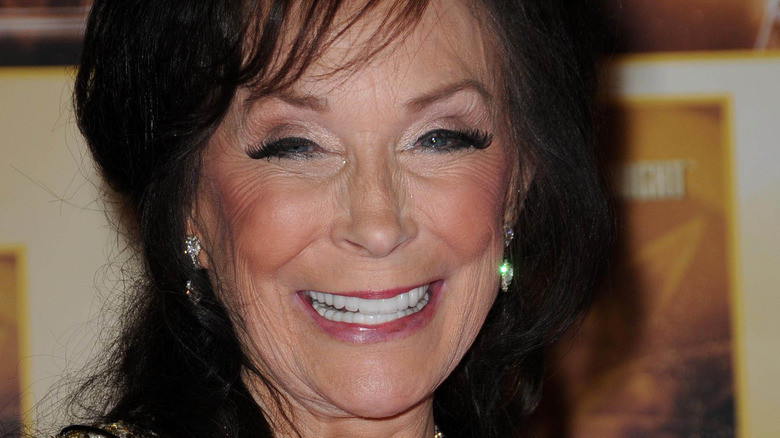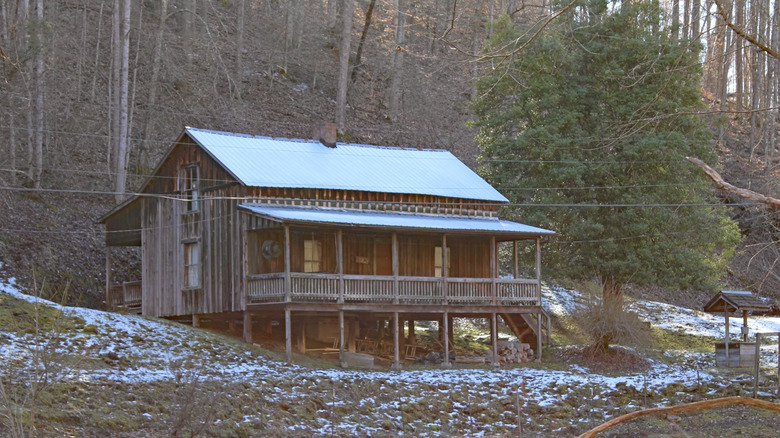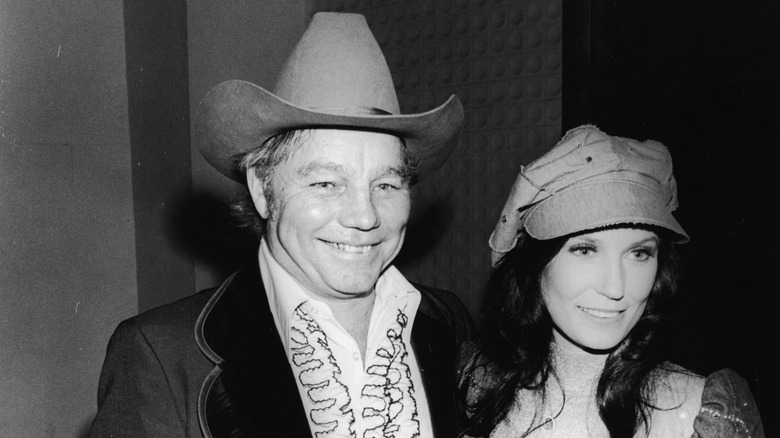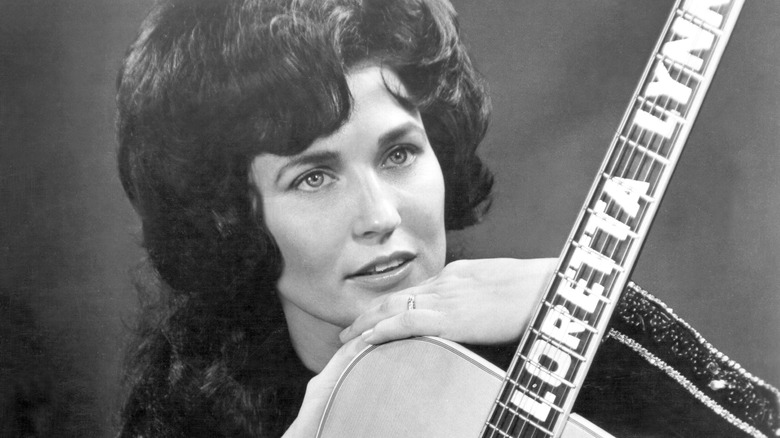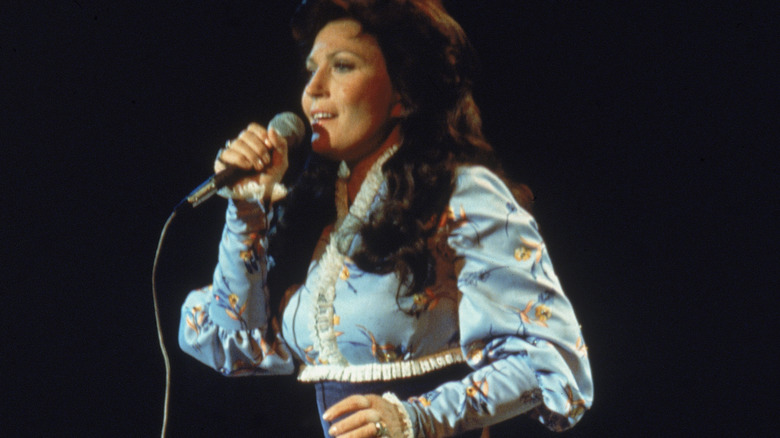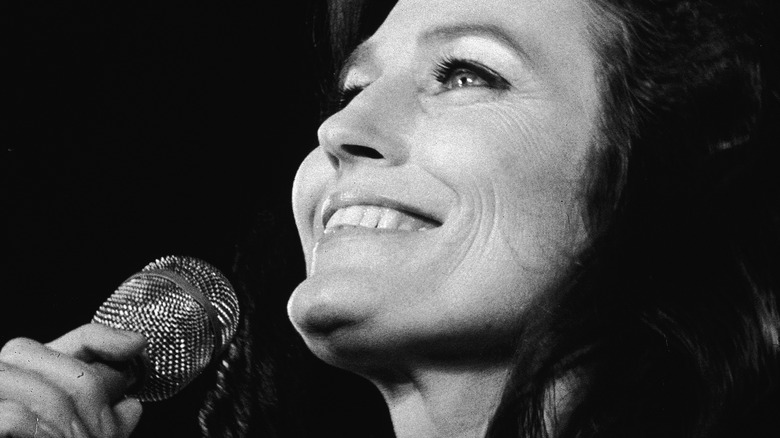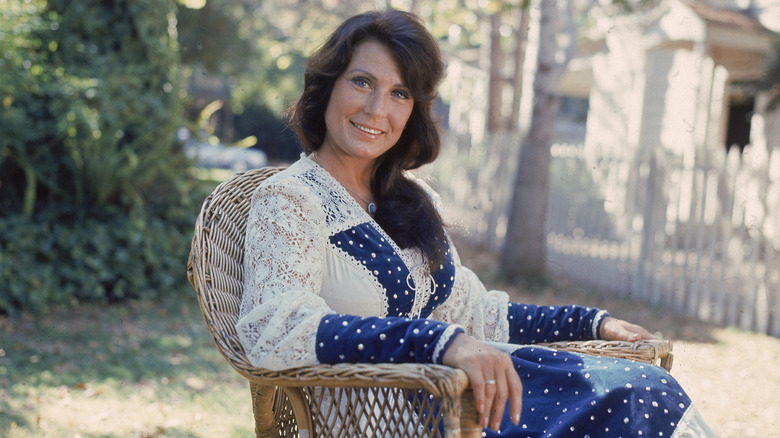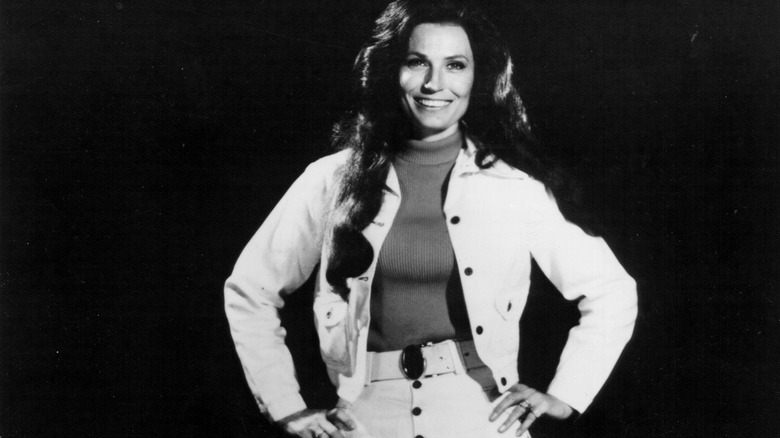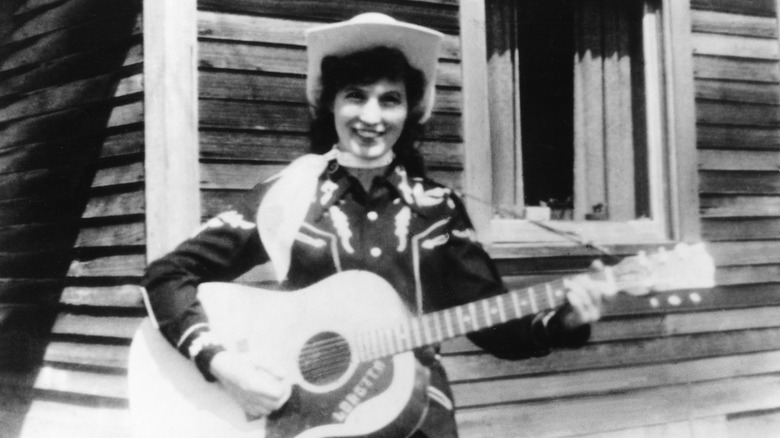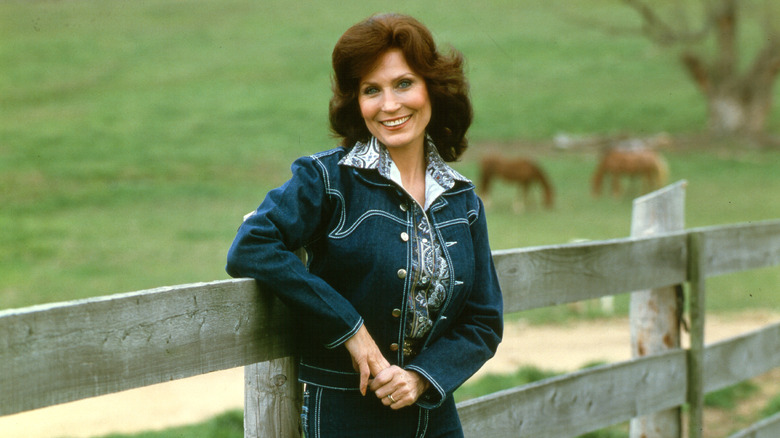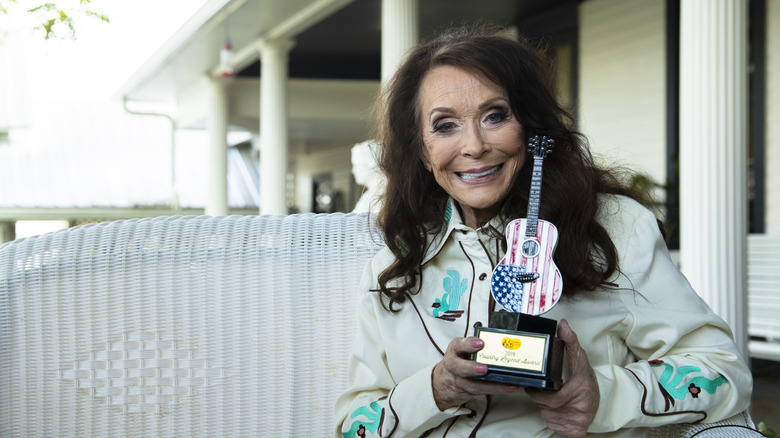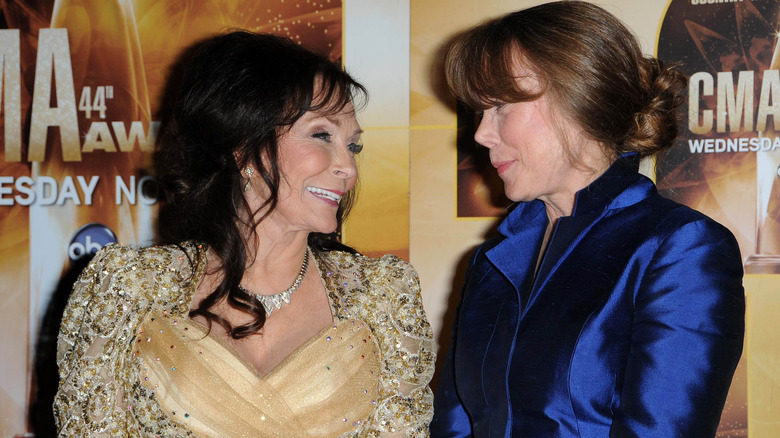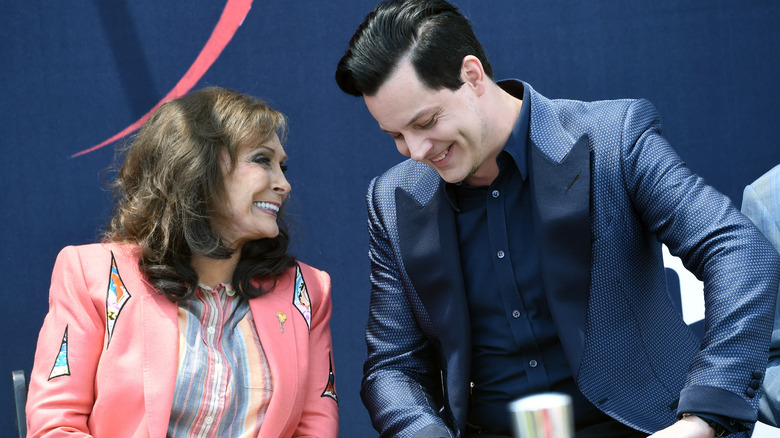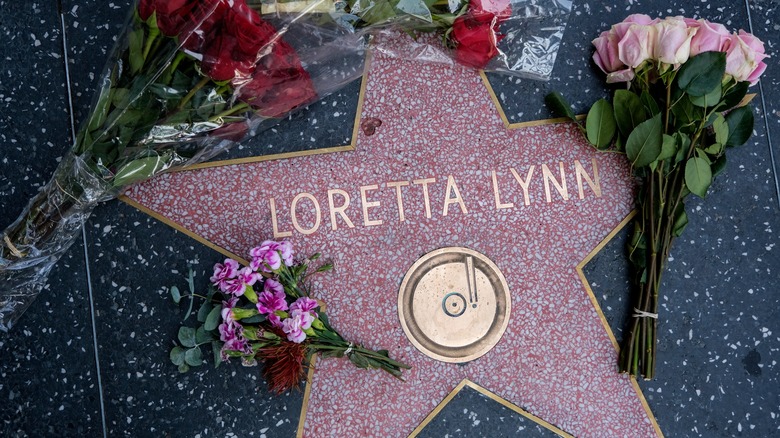Here's How Country Star Loretta Lynn Made Her Fortune
During her lifetime, Loretta Lynn amassed a net worth of $65 million, as estimated by Celebrity Net Worth. Lynn, also known as the Honky Tonk Girl, the Coal Miner's Daughter, and, maybe most fittingly, the Queen of Country Music, was born on April 14, 1932, and died on October 4, 2022. She came from humble beginnings – having grown up in a poor mining town and having four children by the age of 20 — but her circumstances didn't impede her dreams. Instead, she went on to become one of country music's most iconic singers.
As Loretta Lynn herself once said, "You either have to be first, great, or different" — and it's safe to say the country music star was all three (via NPR). She was one of the first female country singers to write songs about real issues women face, and she was great in her talent and ability, and she was undoubtedly different from the country singers that came before her. And although she didn't call herself a feminist, per NPR, we would be remiss not to mention how her outspoken authenticity made her an icon for working-class women all over the world.
Her unflinching honesty, humor, and willingness to push boundaries set the tone for many female musicians to come. Her successful career spanned over six decades and earned her three Grammys as well as a spot in the Country Music Hall of Fame.
She grew up in a mining community
Loretta Lynn was born in Butcher Hollow, Kentucky, and was the second oldest of her eight siblings (via Biography). She lived in a cabin in a small Appalachian mining community, and her family lived in poverty, according to the Washington Post. She went to a one-room schoolhouse but dropped out in elementary school so she could care for her younger siblings while her parents worked.
Despite the financial struggles, Lynn speaks of her childhood on good terms. As her hit song "Coal Miner's Daughter" goes: "We were poor but we had love/That's the one thing that Daddy made sure of." Lynn told Country Living, "The winters were cold, so my mommy glued newspapers and pages from old Sears Roebuck catalogs to the wall to help keep the cold out. We didn't have money for wallpaper, but my mommy made that old house stay warm and beautiful."
Lynn sang in church as a child, per Biography, and continued to sing as she got older, foreshadowing her career to come. In 1948, at age 15, she married Oliver "Doolittle" Lynn, and the two had their first child when Loretta Lynn was 16. The couple moved to Washington state so that Lynn's husband could find better job opportunities, and it was there that her music career really began.
Her husband helped open the doors to her career
According to the Country Music Hall of Fame, Loretta Lynn's husband, Doolittle, bought her a $17 Sears guitar after hearing her sing around the house, and he claimed that Kitty Wells was the only one who could outsing Lynn. Doolittle also encouraged his wife to sing at local venues near their home in Custer, Washington, and set up events for her to perform, helping her eventually form a band.
It's well known that Lynn and her husband had a tumultuous relationship, and her songs hint at alcoholism and infidelity on her husband's part. Lynn told Rolling Stone (via The Washington Post) that when he hit her, she hit him back twice. Despite these concerning relationship dynamics, Lynn consistently credited her husband (who died in 1996 after 48 years of marriage) for his constant encouragement.
In her book, "Still Woman Enough," she wrote of her husband, "He thought I was something special, more special than anyone else in the world, and never let me forget it. That belief would be hard to shove out the door. Doo was my security, my safety net" (via The Washington Post). In the book "Coal Miner's Daughter," she revealed, "If it wasn't for Doolittle, there would be no career. I wouldn't have started singing in the first place, and I wouldn't have had the inspiration for some of my best songs, in the second place" (via People).
She landed a contract with Zero Records in 1960, officially kicking off her career
In 1960, af playing local venues, Loretta Lynnn was able to sign with Zero Records in Vancouver, British Columbia, according to the Country Music Hall of Fame. Lynn's debut single was "I'm a Honky Tonk Girl," which was one of the first songs she ever wrote (va Taste of Country). She and Doolittle traveled around the country to promote the song, asking different radio stations to play it. Eventually, this self-promotion worked, and "I'm a Honky Tonk Girl" reached No. 14 on the 1960 country music charts, according to the Country Music Hall of Fame.
The inspiration for "Honky Tonk Girl" came from a real-life encounter that Lynn had while singing at a nightclub. She told American Songwriter, "'Honky Tonk Girl' came from a lady who kept coming into the little club. ... She told me that her husband had left her for another woman. She'd sit there and cry. She picked strawberries with me during the time when strawberries were ripe. And when strawberry picking was over, she kept coming to the club and crying."
"I'm a Honky Tonk Girl" isn't the only song that is inspired by Lynn's life events. In fact, it is her trademark honesty and authenticity in her songs that allowed her to connect with listeners and continue to launch her career.
Loretta Lynn Sings reached No. 2 on the charts
After the success of "I'm a Honky Tonk Girl," Loretta Lynn moved to Nashville with her family and continued making music. Per All Music, she switched music studios after moving, signing with Decca, and it was with this label that she released her first album, "Loretta Lynn Sings" in 1963. At this point, her career was beginning to pick up. "Loretta Lynn Sings" ultimately ended up as the No. 2 album on the country charts.
Her success continued to build and, in 1966, "Dear Uncle Sam," a song about a woman whose husband is called to war, was Lynn's first self-written song to become a top 10 hit. Though she was well known by this point, her most popular songs weren't her self-penned ones. However, it was important to Lynn to be known as a songwriter. In an interview with American Songwriter, she said she'd rather be remembered as a songwriter than a singer. "Way before I started singing, I was trying to write," she said. "I lived out in the state of Washington and I had my four babies out there. I was trying to write everyday and I didn't know how. So I looked at the songbooks and thought that anyone could do that, so I just started writing," she explained. The fact that so many of her most successful songs were ones that she wrote herself is a testament to her songwriting ability.
Don't Come Home A-Drinkin' was a controversial hit
Loretta Lynn's 1967 single "Don't Come Home A-Drinkin'" was a hit and resonated with other women of the time (via Biography). In signature Loretta Lynn style, the lyrics of the song are frank: "Leave that bottle or me behind/And don't come home a drinkin' with lovin' on your mind." This song was controversial at the time, with the subject matter a bit spicier than what you'd find in other popular songs by female artists. Despite the controversy, the song was a success. It was Lynn's her first No. 1 single on the Billboard country chart, per Wide Open Country.
The song was also nominated for a Grammy and ultimately led to Lynn winning the impressive title of Female Vocalist of 1967 at the Country Music Association. Looking at Lynn's career to this point, "Don't Come Home A-Drinkin'" was a turning point and really put her in the public eye. And it wasn't a stripped-down, squeaky-clean generic song that was expected of female singers at the time — it was bold and brash, but for Lynn, that's what it meant to be true to herself. She told American Songwriter, "I think a lot of people try to write songs that are a little out of reach. And they should just sit down and write what they know." And that's exactly what she did.
She released her most popular song in 1970
It's impossible to talk about Loretta Lynn's success without mentioning her most popular song, "Coal Miner's Daughter." In 1970, she released the catchy, autobiographical tune that tells the story of Lynn's life growing up in Butcher Hollow, Kentucky. In it, she reminisces on the love she felt from her parents despite their lack of money – "Daddy loved and raised eight kids on a miner's pay/Mommy scrubbed our clothes on a washboard every day."
She told American Songwriter, "Everything that I put in that song was true. I lived all of it. I've lived a lot of stuff that I wrote." The song became a No. 1 Billboard hit, and its legacy has lived on to this day. The Recording Industry Association of America named it one of the top 365 songs of the 20th century, alongside other hits like "Over the Rainbow" and "Stairway to Heaven." Rolling Stone ranked it on their list of "500 Greatest Songs of All Time."
Her banned songs were fan favorites
Part of Loretta Lynn's songwriting involved pushing boundaries – a risky choice for a female country singer in the 60s, but it's a big part of what people loved about her. Some of her songs that raised eyebrows include "Rated 'X'" and "Out of My Head and Back in My Bed," as well as "The Pill," a song about the freedom offered by the birth control pill, which was a brand-new invention at the time.
Throughout her career, Lynn had a whopping 14 songs banned from the radio, according to Taste of Country. But the funny thing about these banned songs? They often became No.1 hits. "They started hollering about some of the songs and banned them from the radio," Lynn told American Songwriter. "But immediately, when people would hear they'd been banned from the radio, they'd hit Number 1 in a hurry. And then [radio] would have to play them. If they had listeners, they'd have to play the one that was banned."
Lynn didn't intend to be revolutionary or particularly controversial — she was just being herself and speaking her mind. As the singer once explained, "I wasn't the first woman in country music. I was just the first one to stand up there and say what I thought, what life was about. The rest were afraid to" (via Esquire).
She penned a number of books
Loretta Lynn wrote several best-selling books, including an autobiography called "Coal Miner's Daughter," named after her famous song and album. She also wrote "Me & Patsy Kickin' Up Dirt," which was about her friendship with fellow country singer Patsy Cline; a 2002 memoir titled "Still Woman Enough," a cookbook called "You're Cookin' It: My Favorite Recipes and Memories," and finally a lyric book called "Honky Tonk Girl: My Life in Lyrics."
"Books are like photographs: They take you away to lands and open senses for you," Lynn told The New York Times. "You go to places you've never been and meet people you may never have known." She also shared that her mom influenced the autobiographical way she wrote her songs. "The biggest influence on my writing has been story songs," she said. "Mommy used to sing those and I thought they were great. The best songs I ever wrote tell a story."
Lynn was an avid reader from the beginning of her career, and this hobby has continued late in her life. "I used to read on the tour bus to keep from missing my family. Now I read at night. I live way out and it gets real quiet," she told The New York Times in 2020.
She had multiple streams of income, including a TV show
While her singing/songwriting career certainly gave Loretta Lynn a fortune on its own, her other streams of income undoubtedly added to it. One source of her income was the Loretta Lynn Store, where Lynn sold merchandise including clothing, books, drinkware, and novelty items. Another source of income was Crisco. It may seem odd, but Lynn was the face of Crisco shortening in the 1980s (via Wide Open Country). As part of her collaboration with the brand, she was featured in many Crisco commercials eating Southern meals to promote the product. Lynn's oartnership with Crisco wasn't as random as it may seem, as the country singer was known for her cooking.
In addition to starring in commercials, Lynn was in a TV show for a short time. The 1995 series, "Loretta Lynn & Friends," starred Lynn and other celebrities who would highlight up-and-coming as well as well-known country artists.
The Loretta Lynn Ranch is a huge tourist attraction
In addition to being Loretta Lynn's personal home until her death, the Loretta Lynn Ranch, also known as Hurricane Mills, is a major tourist destination right outside Nashville, Tennessee. The 3,500-acre ranch features multiple museums, an amusement park, and RV, cabin, and tent lodging. It remains open to the public.
A unique part of the Loretta Lynn Ranch is that it has its own zip code and post office, so Lynn essentially owned the entire town where she hosted many events like concerts, horseback trail rides, and more. The ranch has also hosted the yearly AMA Amateur National Motocross Championship since 1982, per Country Living. As one could imagine, having her own tourist destination no doubt added to her fortune.
In addition to her ranch, Lynn owned many other properties, including a Nashville mansion that she sold in September 2022. According to Taste of Country, she lived with her family in a suburban ranch-style home in Nashville when she first moved there in 1963, then moved again to a farmhouse in Goodlettsville before settling down on the Hurricane Mills ranch.
Coal Miner's Daughter was made into a movie – and a profitable one at that
Loretta Lynn's song, then book, "Coal Miner's Daughter" also became a movie. Released in 1980, it was directed by Michael Apted and starred Sissy Spacek. The film, though fictionalized, follows Lynn's story from childhood into adulthood, and then into fame.
According to Wide Open Country, Lynn actually hand-picked Sissy Spacek to play her in the movie after seeing a photo of her. From there, Spacek shadowed Lynn on tour to get a feel for her mannerisms and nail her Appalachian accent. Spacek and Lynn formed a quick friendship. As Spacek said of Lynn to The New York Times, "I just loved her ... there is something so familiar about her. When I met her, it was like meeting a long-lost friend."
The movie was a box office hit, according to First for Women, and received seven Oscar nominations, with Sissy Spacek winning best actress. While it's unknown just how much Lynn took home from the film, "Coal Miner's Daughter" grossed $67 million, solidifying its spot as one of the year's highest-grossing films (via Detroit News). "Coal Miner's Daughter" also served to ramp up Lynn's popularity, as it had begun to wane slightly in the 1980s. Overall, the film was a success for all involved, including Lynn.
She continued to release music later in life
In 2000, Loretta Lynn released an album called "Still Country" and another album "Van Lear Rose" (produced by The White Stripes' Jack White) in 2003. "Van Lear Rose" was Lynn's "country-est" album, as she told American Songwriter." She and Jack White worked well together and even sang a duet on the album called "Portland, Oregan." Lynn told American Songwriter, "Anything [White] did I thought was cool."
Jack White felt similarly about Lynn, telling Entertainment Weekly (via Country Thang Daily), "I want as many people as possible on earth to hear her, because she's the greatest female singer-songwriter of the last century." Lynn and Jack went on to win two Grammy Awards for collaboration on "Van Lear Rose," proving that age did not affect Lynn's talent. The success of "Van Lear Rose" also allowed Lynn to tour and perform regularly, which she continued to do up until 2017, per Rolling Stone.
What happened to her fortune upon her death?
Loretta Lynn accomplished so much in her 60-plus year career — going from extreme poverty to riches, raising six children while being a country music star, pushing the envelope creatively and politically with her music (whether she intended to or not), and paving the way for women in country music for years to come. And Lynn had a lot to show for it — including her $65 million fortune.
It seemed she knew exactly where she wanted her fortune to go because before she passed away, as Lynn had all of her arrangements planned in advance, according to Radar. A friend of the family alleged to the publication that Lynn was also in the process of turning her assets into cash so that her children didn't have to sell her things once she passed away, though it is unclear if that process was completed before she passed. In any case, she left her fortune to her four living children, Clara Marie Lynn, Ernest Ray Lynn, and twins Peggy and Patsy Lynn, according to Music Times.
